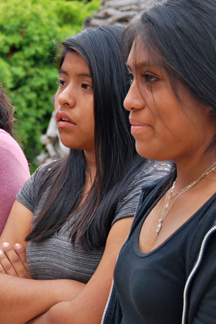Helping Teens Find a Path to STEM Careers
By Madeline McCurry-Schmidt
More than 200 students and their teachers descended from yellow school buses on September 20 at The Scripps Research Institute’s (TSRI) La Jolla campus for the campus’s first “Science Saturday” program, which included a scientific presentation, tours and mentoring.
“We wanted to help high school students learn more about how their futures can unfold,” said Shirley King, community outreach volunteer and organizer of Science Saturday at Scripps California. “Through Science Saturday, the students can find a path to make careers in science happen.”
The campus visit was one of three Science Saturday mornings to be held at TSRI during the 2014–2015 school year. The program will also bring research associates and graduate students from TSRI into seven schools in San Diego County to mentor students and provide resources for science teachers.
The new program was made possible by an anonymous donor in the San Diego area. TSRI researchers, graduate students, graduate office staff and community supporters worked with the San Diego County Office of Education to publicize the Science Saturday program and recruit science classrooms.
The Scientific Method Comes to Life
During the September 20 event, TSRI Professor Donna Blackmond introduced the students to Sandra Encalada, Arlene and Arnold Goldstein Assistant Professor in the Department of Molecular and Experimental Medicine at TSRI. Encalada gave a lecture on communication between neurons, the anatomy of the nervous system and the role of the scientific method in her work.
“I was hoping that they might see that the scientific method is not just a lesson they learn in class, but something that scientists use every day,” said Encalada.
One highlight of the lecture was Encalada’s description of her work with a worm called C. elegans, which she uses as a model system for studying neurons and critical problems that can arise in neurons’ “transport systems” that could lead to neurodegeneration as seen in Alzheimer’s disease. Encalada showed videos of C. elegans wiggling across petri dishes, their genetically modified neurons glowing with florescent markers.
“It’s related to humans in a way,” said Felipe Ramos, a ninth-grader in Solana Beach’s Casa de Amistad tutoring program, after the lecture. “That’s cool—and the worm is transparent.”
The organizers were surprised—and thrilled—to see Encalada’s lecture lead to more than a dozen questions from the students. “The questions were really excellent—I was really impressed,” said Encalada. She added many students came to her after the lecture to ask more technical questions.
UCSD-TV recorded Encalada’s presentation and will make it available to local teachers and students so those unable to attend the event will also be able to use it as a resource.
The Need for Mentors
A major goal of the Science Saturday program is to help students connect with mentors in the field of biomedical research.
“From this past Saturday, the biggest need was to show our students what it takes to be researcher,” said Jorge Valdivieso, a science teacher from San Marcos High School. “It took the mentors years to get to where they are now, and I wanted my students to realize that before they start heading to college.”
Twenty-six of the students visiting the campus were from Solana Beach’s Casa de Amistad program, a nonprofit organization dedicated to tutoring Latino students in coastal North County San Diego. TSRI Research Associates Tamara Johnson and Sophie Wehrkamp-Richter will mentor this group throughout the year.
Johnson said she volunteered to mentor because she wanted to gain experience working with students and she remembered the support she had had from mentors. “They helped give me the confidence to pursue a career in science,” Johnson said.
During their campus tour, several students raised their hands when Johnson asked if any of them were interested in becoming scientists. Ninth-grader Stephanie Medina was curious about becoming a chemist. “What classes do you have to take, and what grades do you have to get in chemistry?” Medina asked.
A Year of Science
When the first Science Saturday event wrapped up, the students went home with a new understanding of what life is like for researchers like Encalada and Johnson. The teachers got to go home with new resources, too—one teacher from San Marcos even won a special raffle prize provided by Art Olson’s lab at TSRI—a physical model that demonstrates how virus pieces can self-assemble with random collisions.
The students will return to campus in January for a lecture about chemistry with TSRI Assistant Professor Ryan Shenvi. Until then, the TSRI mentors will be visiting their classrooms, teaching them more about the world of biomedical science.
Nicole Mione-Green, executive director of Casa de Amistad, said she was looking forward to having TSRI scientists mentor her students as they prepare for challenging biology and chemistry classes.
“This is the first time they’ll be exposed to these kinds of careers,” Mione-Green said.
Send comments to: press[at]scripps.edu














